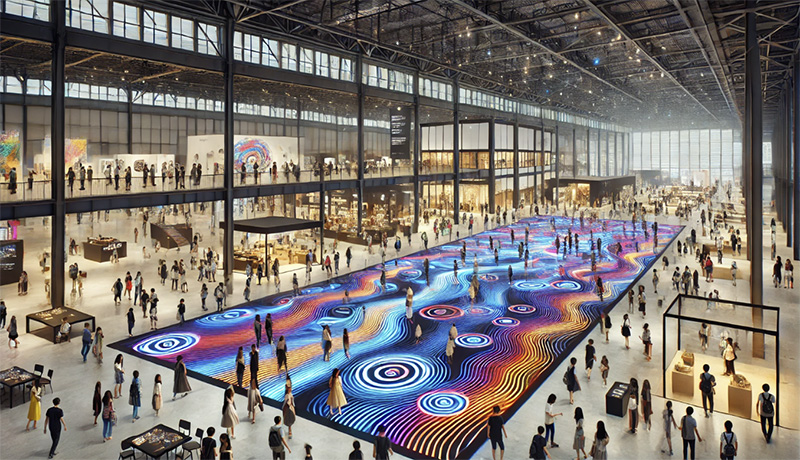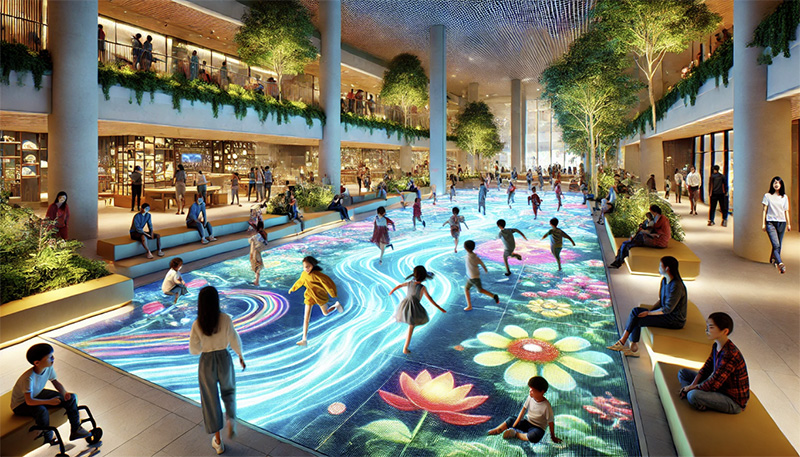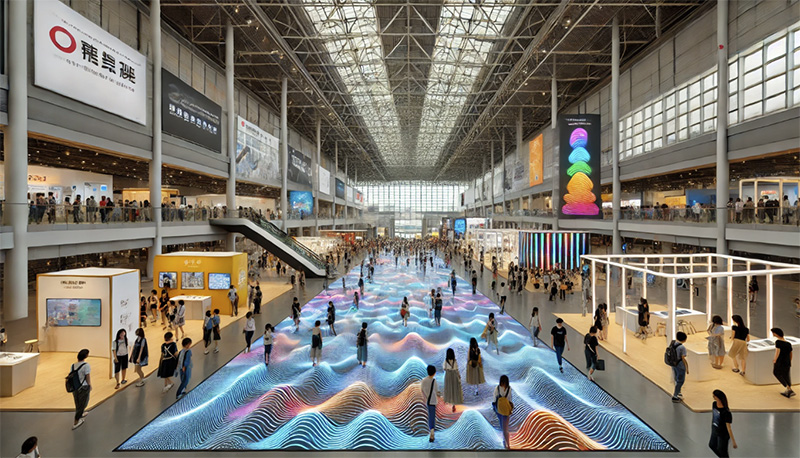Sensor LED floors are versatile and can be installed in a wide range of settings, both indoor and outdoor, where interactivity and dynamic visuals are desired. Their ability to respond to movement, touch, pressure, or proximity makes them ideal for enhancing user experiences in various environments. Below are some common locations where Sensor LED floors can be installed:
1. Retail Stores and Showrooms
Interactive Displays: Sensor LED floors can be used in retail environments to create engaging, interactive shopping experiences. For example, stores can use the floors to guide customers through specific product displays or to showcase promotional content.
Branding and Marketing: Retailers can use these floors to display their logos, branding messages, or product information in an interactive way, catching the attention of passersby.
Wayfinding: In large retail spaces, Sensor LED floors can help guide customers to specific areas or products.

2. Shopping Malls
Engagement Zones: In malls, these floors can be installed in high-traffic areas to create interactive spaces where people can play games, interact with visuals, or engage with promotions.
Events and Promotions: They can be used during mall events or special promotions, adding a fun and modern element to the experience.
Interactive Navigation: Sensor LED floors can provide wayfinding features, helping visitors navigate large shopping malls.
3. Museums and Art Galleries
Interactive Exhibits: In museums and galleries, Sensor LED floors can create immersive, interactive exhibits where visitors engage with the displays by walking on or touching the floor. The floor can change patterns, colors, or animations based on user interaction.
Educational and Entertainment Zones: Sensor LED floors are useful for educational purposes, helping to explain complex concepts through dynamic visuals that respond to the visitor's movements.
Thematic Displays: Museums can design thematic floors that react to specific exhibits, enhancing the storytelling experience.
4. Entertainment Venues (Theaters, Concerts, and Clubs)
Interactive Dance Floors: Nightclubs, music festivals, and dance clubs often use Sensor LED floors as dynamic dance floors that react to the movements and steps of dancers, adding an exciting visual element to the experience.
Live Events: During live performances or concerts, these floors can display synchronized visuals, lighting, and graphics that complement the performance, creating a unique and immersive atmosphere.
Theater and Stage Productions: Sensor LED floors are often used in theaters for creating effects or scenes that change as the actors or performers interact with the stage.

5. Exhibitions and Trade Shows
Booth Displays: At trade shows, Sensor LED floors are used to attract attention to booths and display areas. They can be programmed to show interactive content, product demos, or branding messages that respond to visitors walking over the floor.
Event Engagement: Sensor LED floors can be used in exhibit halls to create interactive floor maps or content displays that activate when users step on certain sections.
6. Public Spaces (Parks, Plazas, and Squares)
Urban Interactivity: In parks or public squares, Sensor LED floors can be used to create playful and engaging public art installations. These interactive floors can react to foot traffic, creating a fun environment for people to explore and enjoy.
Interactive Wayfinding: Public spaces can use these floors to guide people to certain areas or provide information in a visually appealing way.
Smart City Installations: In cities looking to incorporate smart technology, Sensor LED floors can be used in outdoor settings to provide interactive features like directional guidance, event promotions, or environmental information.
7. Corporate Offices
Creative Workspaces: Sensor LED floors can be installed in corporate offices or creative workspaces to create innovative environments. These floors can display company logos, team accomplishments, or dynamic content for collaboration or brainstorming sessions.
Meeting and Conference Rooms: Interactive floors can be used in meeting rooms to enhance presentations, display relevant data, or create engaging experiences during conferences and meetings.
Branding and Team Building: Companies can use these floors for team-building activities, where employees interact with the floor to unlock achievements or participate in collaborative games.

8. Transportation Hubs (Airports, Train Stations)
Wayfinding and Guidance: In airports or train stations, Sensor LED floors can guide passengers to check-in counters, gates, or exits by lighting up the path they need to follow.
Interactive Directories: Interactive maps or directories on the floors can assist travelers in finding shops, restaurants, lounges, or emergency exits.
Public Engagement: At busy transportation hubs, these floors can also entertain passengers by displaying animations or interactive games, particularly in waiting areas.
9. Education and Learning Spaces
Interactive Classrooms: In schools or universities, Sensor LED floors can be used as interactive learning tools where students can engage with educational content or play educational games that respond to their movements.
Exhibition Spaces: Educational museums or science centers often use these floors to create hands-on exhibits, providing a dynamic, interactive learning experience for visitors.
Interactive Labs and Studios: Sensor LED floors can be used in creative studios, innovation labs, or maker spaces to foster a collaborative and engaging atmosphere.
10. Sports Venues and Fitness Centers
Sports Training: Sensor LED floors can be used in sports training facilities or fitness centers to track movements, record exercises, and provide real-time feedback to users.
Interactive Fitness Games: In gyms, these floors can offer interactive fitness games that respond to the movements of participants, turning exercise routines into fun, engaging challenges.
Fan Engagement: In stadiums, LED floors can be used for fan engagement during games, providing fun visuals, stats, or games that react to crowd movements.

11. Hospitality and Hotels
Hotel Lobbies: Sensor LED floors in hotel lobbies can create an impactful first impression by welcoming guests with dynamic visuals or branding messages.
Interactive Lounges: In hotel lounges or event spaces, these floors can create a lively atmosphere with visual effects and interactive content for guests.
Wayfinding: In large hotel complexes, these floors can guide guests to different facilities, such as conference rooms, elevators, or restaurants.
12. Healthcare Facilities
Therapeutic Uses: In hospitals or rehabilitation centers, Sensor LED floors can be used as part of physical therapy programs, where patients engage with the floor to encourage movement, improve balance, or coordinate exercises.
Patient Engagement: These floors can create a calming or fun environment for patients, especially in pediatric wards or treatment areas, helping to reduce stress and anxiety.
Sensor LED floors can be installed in a wide variety of environments, from
retail stores, entertainment venues, and
public spaces to
corporate offices, museums, and
healthcare facilities. Their versatility in responding to touch, pressure, motion, and proximity makes them ideal for enhancing user experiences, engaging customers, providing wayfinding, and creating dynamic environments. Whether for commercial, educational, or entertainment purposes, these interactive floors offer a unique and innovative way to captivate audiences and improve functionality in any space.











